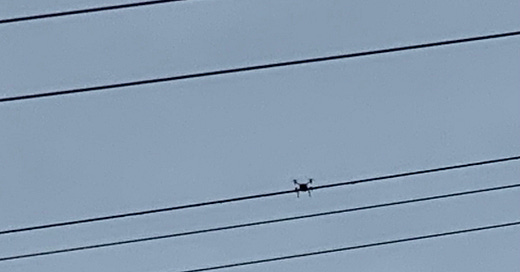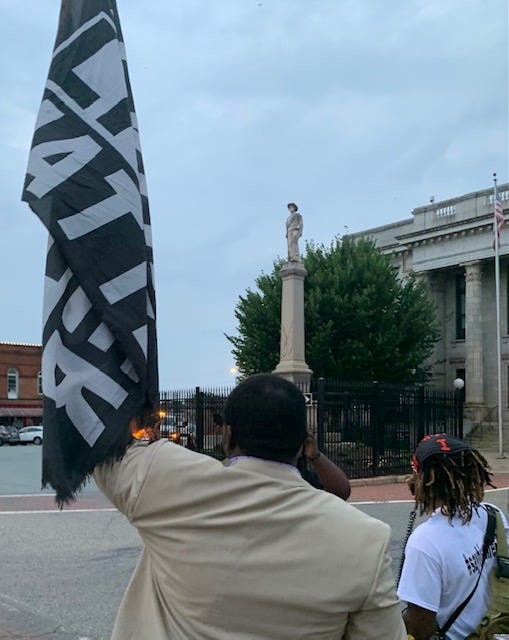I look forward to seeing people differently than I used to, pre-pandemic. Even now, fully vaccinated, I don’t get out as much, and no one outside of my family and a couple of close friends has been in my house for a long time. The class I’m teaching, which I would have ordinarily taught over a week in Vermont, is happening entirely online. So many small things—play dates, last-minute get-togethers, cousin and grandparent visits—have been subtracted.
When I do have plans to see people, I relish them.
This past Wednesday I drove to Durham to see my good friend Cat Warren. She’d planned a simple meal—bread, cheese, tomatoes, figs, ceviche (!), homemade peach sorbet (!!). Well, maybe not so simple. But my favorite sort of meal, enjoyed with one of my favorite people.
On the way there the skies were especially… hazy. The sort of haze that you’d maybe see on an especially humid early morning—not at five in the evening. Somehow, the same way that a black dog-shape reads as beaver, the air read as smoke. I wondered if it could be smoke from the fires, which one of the writers in my class has been experiencing in Oregon.
Cat met me in her driveway. Could I believe that the air was filled with smoke from the Western wildfires?
I could not, and yet I could.
We had a lovely evening, talking and laughing and eating delicious food. But there was a darkness, too—the haze that settled over her garden, the knowledge that so many of our fellow North Carolinians, like people in other (especially Southern) states, have refused a lifesaving, community-saving vaccine.
The next day I sat with my friend and colleague Sylvester Allen on a porch overlooking the Haw River in Saxapahaw. The haze—sorry, the smoke—was worse, and a code orange alert had been declared for most of the state. I asked Sylvester the same question Cat had asked me: could he believe that this smoke had traveled here from Oregon, from Wyoming and California and all the other burning places?
There must be a metaphor there, he said.
We have been talking a lot about the permeability of time and space, the way that old wounds and toxicity carry forward. How a cheap, ugly Confederate statue—erected in 1914 by white supremacists and dedicated by a Reconstruction-era Klan leader—still emits its poisons.
Last night, we stood on the other side of that statue, and there was so much that was poisonous in the air. For many of the several dozen protesters who gathered, there was the traumatic memory of being gassed, assaulted, and arrested at a peaceful march to the polls. Of seeing children and older people pepper-sprayed. There were the self-described “peacekeepers” (the same ones I mentioned last week) standing, menacingly and incongruously, beneath the LOVE ALWAYS WINS mural across the street. There were the “raggedy-ass” (not my words, but not inaccurate) pickup trucks that screeched around the square, coal rolling us with noxious diesel smoke. Ugly shouts from the drivers. There were the police officers on the roof above us. There was an ever-present police drone that hovered and followed us everywhere we marched.
But also:
Speeches, singing, community.
Black Lives Matter flags and homemade signs waving in the breeze.
A reminder from Michael Harris that this is all part of a larger, national conversation, and one that needs “to go on and on and on,” in all the spaces we inhabit.
A suggestion from Cliff Carter that the $800,000 spent in a single year by Alamance County law enforcement on policing protests and protecting that statue “could have fed a lot of people.”
And a warning from Quenclyn Ellison to Alamance County parents yelling about critical race theory in the classroom: “If you’re not teaching your children the cruel history of this county that we are trying to move from, then your children will grow up to be racist.”
There were starlings lighting in the beech trees, and crape myrtle blossoms strewn on the sidewalks.
As we marched past the jail, there was the sound of incarcerated people, who’d heard us chanting, banging on their windows. And our calls back: “We hear you! We love you!”
Stops at the Graham Police department, and the Alamance County Sheriff’s office, to release our eminently reasonable demands: remove the statue. Cease and desist wasteful spending, release police bodycam footage from the October 31, 2020 march. Hold police officers accountable for their actions. Equal justice for all.
As Michael Harris said the other week, “I don’t really believe in justice, but I do believe in accountability.” We can be one another’s accountability family, he told us.
I think that’s the metaphor Sylvester and I were looking for—a more positive one, anyway. That smoke is another important sign that we are accountable to one another, and all connected. When we get a vaccine or encourage a neighbor to get one. When we wear a mask indoors to protect the vulnerable. When we march in the streets, when we share our experience and our learning. When we register people to vote, or sit down to talk about why voting in every election is important. When we demand action on climate change and take steps in our own lives to mitigate it. When we insist that Black Lives Matter.
I like the idea of an accountability family, and I look forward to seeing these folks every Saturday.
(Pictured at the top: a police drone from last night. Read more here from the ACLU on the need to protect citizens’ privacy from aerial surveillance.)
(See you Tuesday with a new animal of the week, friends!)






Thank you Belle
i send love peace strength and thanks to all that you do and the belief and hope we will live to tell the tales